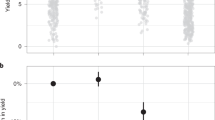Abstract
CONCERNS about genetically engineered crop plants centre on three conjectural risks: that transgenic crop plants will become weeds of agriculture or invasive of natural habitats; that their engineered genes will be transferred by pollen to wild relatives whose hybrid offspring will then become more weedy or more invasive; or that the engineered plants will be a direct hazard to humans, domestic animals or beneficial wild organisms (toxic or allergenic, for example). Here we describe an experimental protocol for assessing the invasiveness of plants. The object is to determine whether genetic engineering for herbicide tolerance affects the likelihood of oilseed rape becoming invasive of natural habitats. By estimating the demographic parameters of transgenic and conventional oilseed rape growing in a variety of habitats and under a range of climatic conditions, we obtain a direct comparison of the ecological performance of three different genetic lines (control, kanamycin-tolerant transgenics and herbicide-tolerant transgenic lines). Despite substantial variation in seed survival, plant growth and seed production between sites and across experimental treatments, there was no indication that genetic engineering for kanamycin tolerance or herbicide tolerance increased the invasive potential of oilseed rape. In those cases in which there were significant differences (such as seed survival on burial), transgenic lines were less invasive and less persistent than their conventional counterparts.
This is a preview of subscription content, access via your institution
Access options
Subscribe to this journal
Receive 51 print issues and online access
$199.00 per year
only $3.90 per issue
Buy this article
- Purchase on Springer Link
- Instant access to full article PDF
Prices may be subject to local taxes which are calculated during checkout
Similar content being viewed by others
References
Crawley, M. J. Phil. Trans. R. Soc. Lond. B 314, 711–731 (1986).
Rees, M., Kohn, D., Hails, R., Crawley, M. & Malcolm, S. in Biological Monitoring of Genetically Engineered Plants and Microbes (ed. MacKenzie, D. R. & Henry, S. C.) 9–24 (USDA and Clemson Univ., South Carolina, 1991).
Regal, P. J. Trends Ecol. Evol. 6, S47–S49 (1988).
National Academy of Sciences Introduction of Recombinant DNA-engineered Organisms into the Environment (National Academy, Washington, 1987).
Rees, M. & Long, M. J. Am. Nat. 139, 484–508 (1992).
Rees, M. & Long, M. J. Am. Nat. 141, 233–262 (1993).
Crawley, M. J. Phil. Trans. R. Soc. Lond. B 330, 123–140 (1990).
Thompson, C. J. et al. EMBO J. 6, 2519–2523 (1987).
Sambrooke, J., Fritsch, E. F. & Maniatis, T. Molecular Cloning: A Laboratory Manual (Cold Spring Harbour Press, New York, 1989).
Author information
Authors and Affiliations
Rights and permissions
About this article
Cite this article
Crawley, M., Hails, R., Rees, M. et al. Ecology of transgenic oilseed rape in natural habitats. Nature 363, 620–623 (1993). https://doi.org/10.1038/363620a0
Received:
Accepted:
Issue Date:
DOI: https://doi.org/10.1038/363620a0
This article is cited by
-
Drought Stress in Brassica napus: Effects, Tolerance Mechanisms, and Management Strategies
Journal of Plant Growth Regulation (2023)
-
Advantages, risks and legal perspectives of GMOs in 2020s
Plant Biotechnology Reports (2021)
-
Modeling pollen-mediated gene flow from glyphosate-resistant to -susceptible giant ragweed (Ambrosia trifida L.) under field conditions
Scientific Reports (2017)
-
Transportability of confined field trial data from cultivation to import countries for environmental risk assessment of genetically modified crops
Transgenic Research (2015)
-
The effect of Bt-transgene introgression on plant growth and reproduction in wild Brassica juncea
Transgenic Research (2015)
Comments
By submitting a comment you agree to abide by our Terms and Community Guidelines. If you find something abusive or that does not comply with our terms or guidelines please flag it as inappropriate.



